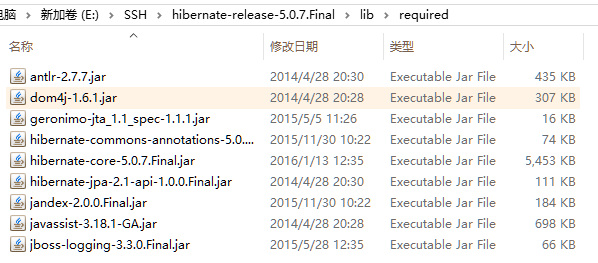hibernate基础了解1
1.hibernate概述
hibernate框架是帮我们完成数据库操作的,应用于dao层;
2.对象的持久化
指把内存中的对象形式的数据,转换为数据库的数据,把它永久的保存下来.
3.好处
操作数据库的时候,可以以面向对象的方式来完成,不需要书写SQL语句
4.ORM:object relation mapping.对象关系映射
利用描述对象和数据库表之间映射的元数据,自动把java应用程序中的对象,持久化到关系型数据库的表中,通过操作java对象,就可以完成对数据库表的操作.
5.hibernate运行项目必须的jar包


6.hibernate框架的搭建
创建数据库:准备表,实体
public class Customer { /* * CREATE TABLE `cst_customer` ( `cust_id` BIGINT(32) NOT NULL AUTO_INCREMENT COMMENT '客户编号(主键)', `cust_name` VARCHAR(32) NOT NULL COMMENT '客户名称(公司名称)', `cust_source` VARCHAR(32) DEFAULT NULL COMMENT '客户信息来源', `cust_industry` VARCHAR(32) DEFAULT NULL COMMENT '客户所属行业', `cust_level` VARCHAR(32) DEFAULT NULL COMMENT '客户级别', `cust_linkman` VARCHAR(64) DEFAULT NULL COMMENT '联系人', `cust_phone` VARCHAR(64) DEFAULT NULL COMMENT '固定电话', `cust_mobile` VARCHAR(16) DEFAULT NULL COMMENT '移动电话', PRIMARY KEY (`cust_id`) ) ENGINE=INNODB AUTO_INCREMENT=1 DEFAULT CHARSET=utf8; */ private Long cust_id; private String cust_name; private String cust_source; private String cust_industry; private String cust_level; private String cust_linkman; private String cust_phone; private String cust_mobile; public Long getCust_id() { return cust_id; } public void setCust_id(Long cust_id) { this.cust_id = cust_id; } public String getCust_name() { return cust_name; } public void setCust_name(String cust_name) { this.cust_name = cust_name; } public String getCust_source() { return cust_source; } public void setCust_source(String cust_source) { this.cust_source = cust_source; } public String getCust_industry() { return cust_industry; } public void setCust_industry(String cust_industry) { this.cust_industry = cust_industry; } public String getCust_level() { return cust_level; } public void setCust_level(String cust_level) { this.cust_level = cust_level; } public String getCust_linkman() { return cust_linkman; } public void setCust_linkman(String cust_linkman) { this.cust_linkman = cust_linkman; } public String getCust_phone() { return cust_phone; } public void setCust_phone(String cust_phone) { this.cust_phone = cust_phone; } public String getCust_mobile() { return cust_mobile; } public void setCust_mobile(String cust_mobile) { this.cust_mobile = cust_mobile; } @Override public String toString() { return "Customer [cust_id=" + cust_id + ", cust_name=" + cust_name + "]"; } }
对象与表的映射配置文件
导入约束:hibernate-mapping_3.0dtd
orm元数据:
<?xml version="1.0" encoding="UTF-8"?> <!DOCTYPE hibernate-mapping SYSTEM "hibernate-mapping-3.0.dtd"> <!-- package属性:填写一个包名.在元素内部凡是需要书写完整类名的属性,可以直接写简答类名了. --> <hibernate-mapping package="com.learn.domain"> <!-- class元素: 配置实体与表的对应关系的 name: 完整类名 table:数据库表名 --> <class name="Customer" table="cst_customer"> <!-- id元素:配置主键映射的属性 name: 填写主键对应属性名 column(可选): 填写表中的主键列名.默认值:列名会默认使用属性名 type(可选):填写列(属性)的类型.hibernate会自动检测实体的属性类型. 每个类型有三种填法: java类型|hibernate类型|数据库类型 not-null(可选):配置该属性(列)是否不能为空. 默认值:false length(可选):配置数据库中列的长度. 默认值:使用数据库类型的最大长度 --> <id name="cust_id" column="cust_id"> <generator class="native"></generator> </id> <!-- property元素:除id之外的普通属性映射 name: 填写属性名 column(可选): 填写列名 type(可选):填写列(属性)的类型.hibernate会自动检测实体的属性类型. 每个类型有三种填法: java类型|hibernate类型|数据库类型 not-null(可选):配置该属性(列)是否不能为空. 默认值:false length(可选):配置数据库中列的长度. 默认值:使用数据库类型的最大长度 --> <property name="cust_name" column="cust_name"></property> <property name="cust_source" column="cust_source"></property> <property name="cust_industry" column="cust_industry"></property> <property name="cust_level" column="cust_level"></property> <property name="cust_linkman" column="cust_linkman"></property> <property name="cust_phone" column="cust_phone"></property> <property name="cust_mobile" column="cust_mobile"></property> <!-- 一对多关系 --> <!-- 集合,一对多关系,在配置文件中配置 --> <!-- name属性:集合属性名 column属性: 外键列名 class属性: 与我关联的对象完整类名 --> <!-- 级联操作: cascade save-update: 级联保存更新 delete:级联删除 all:save-update+delete 级联操作: 简化操作.目的就是为了少些两行代码. --> <!-- inverse属性: 配置关系是否维护. true: customer不维护关系 false(默认值): customer维护关系 inverse属性: 性能优化.提高关系维护的性能. 原则: 无论怎么放弃,总有一方必须要维护关系. 一对多关系中: 一的一方放弃.也只能一的一方放弃.多的一方不能放弃. --> <!-- <set name="linkMans" inverse="true" cascade="save-update"> <key column="lkm_cust_id"></key> <one-to-many class="LinkMan" /> </set> --> </class> </hibernate-mapping>
书写主配置文件
<?xml version="1.0" encoding="UTF-8"?> <!DOCTYPE hibernate-configuration SYSTEM "hibernate-configuration-3.0.dtd"> <hibernate-configuration> <session-factory> <!-- #hibernate.dialect org.hibernate.dialect.MySQLDialect #hibernate.dialect org.hibernate.dialect.MySQLInnoDBDialect #hibernate.dialect org.hibernate.dialect.MySQLMyISAMDialect #hibernate.connection.driver_class com.mysql.jdbc.Driver #hibernate.connection.url jdbc:mysql:///test #hibernate.connection.username gavin #hibernate.connection.password --> <property name="hibernate.connection.driver_class">com.mysql.jdbc.Driver</property> <property name="hibernate.connection.url">jdbc:mysql:///hibernate_01</property> <property name="hibernate.connection.username">root</property> <property name="hibernate.connection.password">root</property> <!-- 方言 --> <property name="hibernate.dialect">org.hibernate.dialect.MySQLMyISAMDialect</property> <!-- 线程绑定 --> <property name="current_session_context_class">thread</property> <!-- 将hibernate生成的sql语句打印到控制台 --> <property name="hibernate.show_sql">true</property> <!-- 将hibernate生成的sql语句格式化(语法缩进) --> <property name="hibernate.format_sql">true</property> <!-- ## auto schema export 自动导出表结构. 自动建表 #hibernate.hbm2ddl.auto create 自动建表.每次框架运行都会创建新的表.以前表将会被覆盖,表数据会丢失.(开发环境中测试使用) #hibernate.hbm2ddl.auto create-drop 自动建表.每次框架运行结束都会将所有表删除.(开发环境中测试使用) #hibernate.hbm2ddl.auto update(推荐使用) 自动生成表.如果已经存在不会再生成.如果表有变动.自动更新表(不会删除任何数据). #hibernate.hbm2ddl.auto validate 校验.不自动生成表.每次启动会校验数据库中表是否正确.校验失败. --> <property name="hibernate.hbm2ddl.auto">update</property> <!-- 引入orm元数据 路径书写: 填写src下的路径 --> <mapping resource="com/learn/domain/Customer.hbm.xml" /> </session-factory> </hibernate-configuration>
书写代码测试:
public class Demo1 { @Test public void test() { //创建加载类对象 Configuration con = new Configuration().configure(); //创建session工厂 SessionFactory sessionFactory = con.buildSessionFactory(); //开启session对象 Session session = sessionFactory.openSession(); //开启并获得事物操作对象 Transaction tx = session.beginTransaction(); Customer c = new Customer(); c.setCust_name("111"); session.save(c); tx.commit(); session.close(); sessionFactory.close(); } }
7.configuration配置对象
主要用于hibernate框架加载映射文件
在使用hibernate时,首先要创建configuration实例,configuration实例主要用于启动,加载,管理hibernate的配置文件信息,
在启动hibernate的过程中,configuration实例首先确定hibernate配置文件的位置,然后读取相关配置,最后创建一个唯一的
sessionFactory实例.configuration对象只存在于系统的初始化阶段,它将sessionfactory创建完成后,就完成了自己的使命.
8.sessionfactory:session工厂对象
sessionfactory接口负责hibernate的初始化和建立session对象,它在hibernate中起到一个缓冲区的作用,
hibernate可以将自动生成的SQL语句,映射数据以及某些可以重复利用的数据放在这个缓冲区中,同时它还保存了对象数据库配置的所有映射
关系
9.session
session是应用程序与数据库之间交互操作的一个单线程对象,是hibernate运作的中心,是hibernate运作的中心,它的主要功能是为持久化对象提供创建,读取和删除的功能,所有持久化对象必须在session的管理下才可以进行持久化操作
创建sessionFactory实例后,就可以通过它获取session实例.获取session实例有两种方式,一种是通过openSession()方法,另一种是通过
getCurrentSession()方法
以上两种获取session实例方式的主要区别是,采用openSession 方法 获取Session实例时,SessionFactory直接创建一个新的Session实例,
并且在使用完成后需要调用close方法进行手动关闭.而getCurrentSession方法创建的session实例会被绑定到当前线程中,它在提交或回滚操作时
会自动关闭
save(),update(),saveOrUpdate()方法:用于增加和修改对象
delete()方法:用于删除对象
get()和load()方法:根据主键查询
creatQuery()和createSQLQuery()方法:用于数据库操作对象
createCriteria()方法:条件查询
10.transaction
transaction接口主要 用于管理事务,它是hibernate的数据库事务接口.
transaction接口的事务对象是通过session对象开启的
commit()方法:提交相关联的session实例
rollback()方法:撤销事务操作
session执行完数据操作后,要使用transaction接口的commit方法进行事务提交,才能真正的将数据操作同步到数据库中,
发生异常时,需要使用rollback方法进行事务回滚,一避免数据发生错误.


